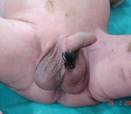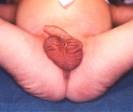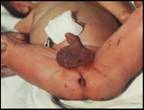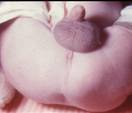INFORMATION AVAILABLE IN ENGLISH, GUJARATI AND HINDI
What is an Imperforated anus / Anorectal anomaly?
This is a disorder affecting the anus and the rectum, the last part of the digestive system. After food has been digested it passes through the small bowel into the large bowel. The faeces (stools) are stored in the rectum until the muscles receive a message from the brain to empty the bowel. The faeces then pass out through the anus.
There are two types of anorectal anomaly – low anorectal anomaly and high anorectal anomaly. A low anorectal anomaly is where the anus is closed over, in a slightly different position or narrower than usual. A high anorectal anomaly is where the bowel has a closed end and does not connect with the anus or it connects with another part of the body through a passage called a fistula.
An anorectal anomaly can be associated with other problems, but the doctor will examine your child closely to check if this is the case.
What are the symptoms of an anorectal anomaly?
Symptoms vary according to the type of anorectal anomaly. They are classified into two types (high and low) depending on where the bowel ends.
If your child has a low anorectal anomaly, faeces cannot be removed from the body as usual, and so builds up in the bowel. Your child will not be able to pass meconium – the dark faeces passed in the first few days of life. The build up of faeces in the bowel can cause a swollen abdomen and vomiting.
Low Anorectal Malformations
If your child has a high anorectal anomaly without a fistula, he or she will not be able to pass meconium and will develop similar symptoms.
Anorectal Malformation without fistula
If your child has a high anorectal anomaly with a fistula, the faeces will be able to pass out of the body, usually through the vagina in girls or through the urethra in boys.
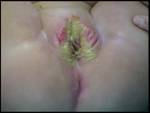
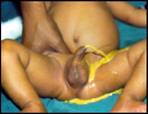
Anorectal Malformation without fistula
How is an anorectal anomaly diagnosed?
An anorectal anomaly is usually diagnosed soon after birth, on examination, or when the baby fails to pass meconium. The doctor may suggest scans to give a clearer picture of the type of anorectal anomaly and whether there is a fistula.
What causes an anorectal anomaly and how common is it?
An anorectal anomaly happens when the bowel does not form properly while the baby is developing in the womb. We do not know exactly what caused this, but it was not due to anything that happened during pregnancy.
About one in 3,000 babies are born with an anorectal anomaly, with more boys than girls affected.
What treatments are available and are there any alternatives?
The treatment depends on the type of anorectal anomaly. All types of anorectal anomaly will need an operation under general anaesthetic – usually an ‘anoplasty’ if your child has a low anorectal anomaly or a series of operations if your child has a high anorectal anomaly.
The first operation is to create a loop stoma (an artificial way of disposing of waste matter) usually in the days after birth.
The second is a ‘pull-through’ operation to join the bowel to a newly created anus. This usually happens when your child is a few months old and has gained weight.
The final stage is to close up the stoma. This happens when your child’s bowel and anus is working well a few weeks after the second operation. The three operations are usually completed by the time your child is six months old. There are no alternatives to these operations, as your child needs to be able to pass faeces to prevent it building up in the bowel, which could lead to discomfort and infection.
What does the operation involve?
Anoplasty – the surgeon will open up the anus (if it was closed over), move the anus (if it was in a slightly different place to usual) or widen the anus (if it was narrower than usual).
Creation of loop stoma – the surgeon will bring the bowel to an artificial opening in your child’s abdomen (stoma).
‘Pull-through’ operation – the surgeon will create a new anus and then separate the bowel from the fistula (if there is one) and bring it down to join the newly created anus. He or she will then close up the fistula. Your child will continue to use the stoma so that the bowel and anus can rest and heal.
Closure of loop stoma – the surgeon will disconnect the the bowel from the stoma and close it to form a fully working bowel.
What happens afterwards?
Your child will come back to the ward to recover. We will keep your child as comfortable as possible, by giving regular pain relieving medications. For the first few days, the pain relief will usually be given through a ‘drip’ and then, when your child is more comfortable, in the form of medicines to be swallowed.
For the first few days, your child will need a ‘drip’ of fluids until he or she feels like eating and drinking again. This will also allow the bowel to rest and start to heal. After a while, you can start to feed your child again, starting with small amounts, and increasing the amount as he or she tolerates it.
If your child has had a new anus created, you may be asked to stretch (dilate) it using a probe called a dilator. The doctor will show you how to do this before you go home. You will need to start with a small size dilator and gradually increase the size until the anus is the right size
If your child has had the stoma and mucous fistula created, the nurses will teach you how to look after them both. We will make sure you feel confident before you go home.
What is the outlook for children with anorectal anomaly?
The outlook for children with anorectal anomaly depends on the type of abnormality. Your child may need extra bowel training at a later stage to learn when and how to empty his or her bowels. He or she may also need some extra help in the form of enemas or washouts, but these will be explained to you if they are needed. However, some children continue to have bowel problems for many years after the operations, but this depends on the original severity of the anorectal anomaly.
Your child will need regular check ups with your doctor at the hospital. These happen regularly until your child is a teenager.
Some girls who have had an anorectal anomaly may be better having a caesarean section rather than normal childbirth. This will put less strain on the operation site and is less likely to cause problems in the future.
Publications on the subject : M.R.I. in A.R.M.
GUJARATI
સંડાસની જગ્યા ન હોવી – મળમાર્ગ ન હોવો
દર ૩૦૦૦ એ એક બાળક આ ખોડ સાથે જન્મ લેતું હોય છે. છોકરાંઓમાં આ ખોડ વધુ જાવામાં આવતી હોય છે. આ ખોડ થવાનું કોઈ ચોક્કસ કારણ જાણી શકાયું નથી અને તે ડિલિવરી પહેલાં માતાની સોનોગ્રાફી દ્વારા જાણી શકાતી નથી. આ ખોડ બે પ્રકારની હોય છે. ૧. હાઈ ૨. લો.
૧) ‘હાઈ’ વેરાઈટી : આ ખોડમાં બાળકનાં મળમાર્ગનું આંતરડું પેશાબના રસ્તા સાથે અને બેબીમાં યોનિમાર્ગ સાથે જાડાયેલું હોય છે. આ કેસમાં બાળકને જન્મ પછી તરત આૅપરેશન કરી પેટ પર મળ માટે ટેમ્પરરી રસ્તો કરવો પડે છે. આને કોલોસ્ટોમી કહેવાય છે. બાળક ૩-૫ માસનું થાય ત્યારે પેશાબ સાથેનું કનેક્શન દૂર કરી મળમાર્ગ યોગ્ય જગ્યાએ બનાવવાનું ઓપરેશન કરવામાં આવે છે. ત્યાર બાદ કોલોસ્ટોમીને બંધ કરી દેવામાં આવે છે. સીલેક્ટેડ કેસમાં આ ત્રણેય આૅપરેશન એક જ સ્ટેજમાં કરી શકાય છે.
૨) ‘લો’ વેરાઈટી : આ કેસમાં આંતરડાને પેશાબનાં રસ્તા સાથે કોઈ જાડાણ હોતું નથી. આ કેસમાં પેટે કોલોસ્ટોમી કરવાની જરૂર પડતી નથી અને એક જ આૅપરેશન દ્વારા બાળક સાજું થઈ જતું હોય છે. આ ખોડ સાથે બીજી ખોડ-ખાપણ નથી તે જાણવા માટે એક્ષરે, સોનોગ્રાફી અને ઈકોકાર્ડીયોગ્રાફીની તપાસ થાય છે.
સચોટ આૅપરેશન અને યોગ્ય કાળજી મળે તો આ બાળકો બીજા બાળકોની જેમ નોર્મલ જીવન જીવી શકે છે. •
HINDI
मल मार्ग का न होना
हर ३००० बच्चों में एक बच्चा इस विसंगति के साथ जन्म लेता है। प्रसूति से पूर्व सोनोग्ा्राफी के द्वारा भी इसका पता लगाना कठीन होता है। यह विसंगति दो प्रकार की होती है। (१) ‘लो’ (कम) विसंगति, (२) ‘हाई’ (उच्च) विसंगति।
‘लो’ (कम) प्रकार ः गुदा मार्ग अपने निर्धारित आकार या उचित स्थान पर स्थित नहीं होता है अथवा गुदा मार्ग पूर्णरूप से बंद होता है।
‘हाई’ (उच्च) प्रकार ः गुदा मार्ग पूर्णरूप से बंद होता है और वह शरीर के अन्य अंग के साथ एक मार्ग के द्वारा जुड़ा होता है जिसे फिस्च्युला कहा जाता है।
इसका पता जन्म के तुरंत बाद जांच के उपरांत अथवा जब बच्चा अपना प्रथम मलत्याग नहीं कर पाता तब चलता है। बच्चे में इस प्रकार की विसंगति के साथ किसी अन्य प्रकार की विसंगति तो नहीं है इसकी पुष्टि करने के लिए एक्स-रे, सोनोग्ा्राफी और इकोकार्डियोग्ा्राफी द्वारा जांच की आवश्यकता होती है।
‘लो’ विसंगतिः ऐसे में गुदासंधान (एनोप्लास्टी) की आवश्यकता होती है।
‘हाई’ विसंगतिः इसमें बच्चे पर त्रि-स्तरीय सर्जरी की आवश्यकता होती है। कुछ चुनिंदा मामलों में केवल एक-स्तरीय ऑपरेशन भी किया जा सकता है।
गुदा एवं मलाशय संबंधी विसंगति के संबंध में बच्चे का दृष्टिकोण विसंगति के प्रकार और उसकी तीव्रता पर निर्भर करता है। बाद में, बच्चे को अपने पेट को कब और कैसे साफ करना चाहिए इस बात के प्रशिक्षण की आवश्यकता हो सकती है। उसे अपने पेट को साफ करने के लिए जुलाब दिए जाने की आवश्यकता भी हो सकती है। यह विसंगति वाली लड़कियों में सामान्य प्रसूति के बजाय सीजेरियन सेक्शन अधिक उपयुक्त होता है। इससे उनके ऑपरेशन के स्थान पर कम तनाव पड़ेगा और भविष्य में किसी प्रकार की समस्या होने की संभावना कम होती है।•

